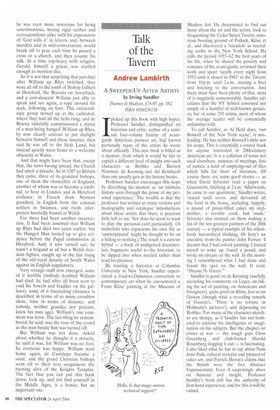Talk of the Tavern
Andrew Lambirth
A SWEEPER-UP AFTER ARTISTS by Irving Sandler Thames & Hudson, £18.95, pp. 382, ISBN 0500238138 Ipicked up this book with high hopes. Professor Sandler, distinguished art historian and critic, author of a seminal four-volume history of avantgarde American postwar art, had known personally many of the artists he wrote about officially. This new book is billed as a memoir, from which it would be fair to expect a different level of insight into such characters as Rothko and Barnett Newman, de Kooning and Ad Reinhardt than one usually gets in the history books.
Professor Sandler encourages this hope by describing his memoir as 'an intimate history seen through the prism of my personal experience'. The trouble is that the professor has written so many reviews and monographs and catalogue introductions about these artists that there is precious little left to say. Nor does he seem to want to play the personal card particularly. (A memoirist who represents his own life as 'unexceptional' might be thought to be on a hiding to nothing.) The result is a curious hybrid — a book of undigested documentary fragments useful to the historian, to be dipped into when needed rather than read for pleasure.
By training a historian at Columbia University in New York, Sandler experienced a road-to-Damascus conversion to contemporary art when he encountered a Franz Kline painting at the Museum of Modern Art. He determined to find out more about the art and the artists, took to frequenting the Cedar Street Tavern, notorious boozing ground of Pollock, Kline et al., and discovered a 'vocation' as recording scribe to the New York School. He calls the period 1955-62 the best years of his life, when he shared the poverty and romance of the avant-garde, reviewed their work and spent 'nearly every night from 1953 until it closed in 1963' at the Tavern, from 10 p.m. until 2 a.m., nursing a beer and listening to the conversation. And there must have been plenty of that, most of it singularly unmemorable. Sandler calculates that the NY School consisted not simply of a handful of well-known geniuses, but of some 250 artists, most of whom the average reader will be contentedly unfamiliar with.
To call Sandler, as Al Held does, 'our Boswell of the New York scene', is misleading. He has neither Boswell's style nor his scope. This is essentially a source book for anyone interested in 20th-century American art. It is a collation of notes not used elsewhere, minutes of meetings, lists of names; a kind of emptying-out of files which falls far short of literature. Of course there are some good stories — as when David Sylvester read a paper on Giacometti, finishing at 2 a.m. 'Afterwards, he came to our apartment,' Sandler writes, 'stayed until seven, and devoured all the food in the house, including, happily, a pound of prune-filled cakes my stepmother, a terrible cook, had made.' Sylvester also insisted on them making a list of the ten greatest painters of the 20th century — a typical example of his relentlessly hierarchical thinking. Or here's an anecdote from the painter John Ferren: 'I dreamt that I had solved painting. I forced myself to wake up, found a pencil, and wrote my dream on the wall. In the morning I remembered what I had done and found the spot on the wall. It read, "Dream 76. Green."
Sandler is good on de Kooning (usefully recording his comments on Leger, on faking the act of painting, on Americans and foreigners), quite good on Kline, less so on Guston (though what a revealing remark of Guston's: 'There is no torture in Hofmann's pictures'), and depressing on Rothko. Too many of the character sketches are skimpy, as if Sandler has not bothered to exercise his intelligence or imagination on his subjects. But the chapter on critics at war — the tough guys Clem Greenberg and club-footed Harold Rosenberg slogging it out — is fascinating. I also liked what he has to say about Nam June Paik, cultural terrorist and pioneer of video art, and Patrick Heron's claims that the British were the first Abstract Expressionists. Even if surprisingly short on humour and insight, Professor Sandler's book still has the authority of first-hand experience, and for this it will be valued.


















































































 Previous page
Previous page